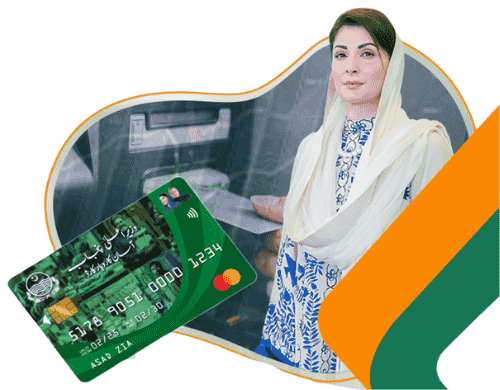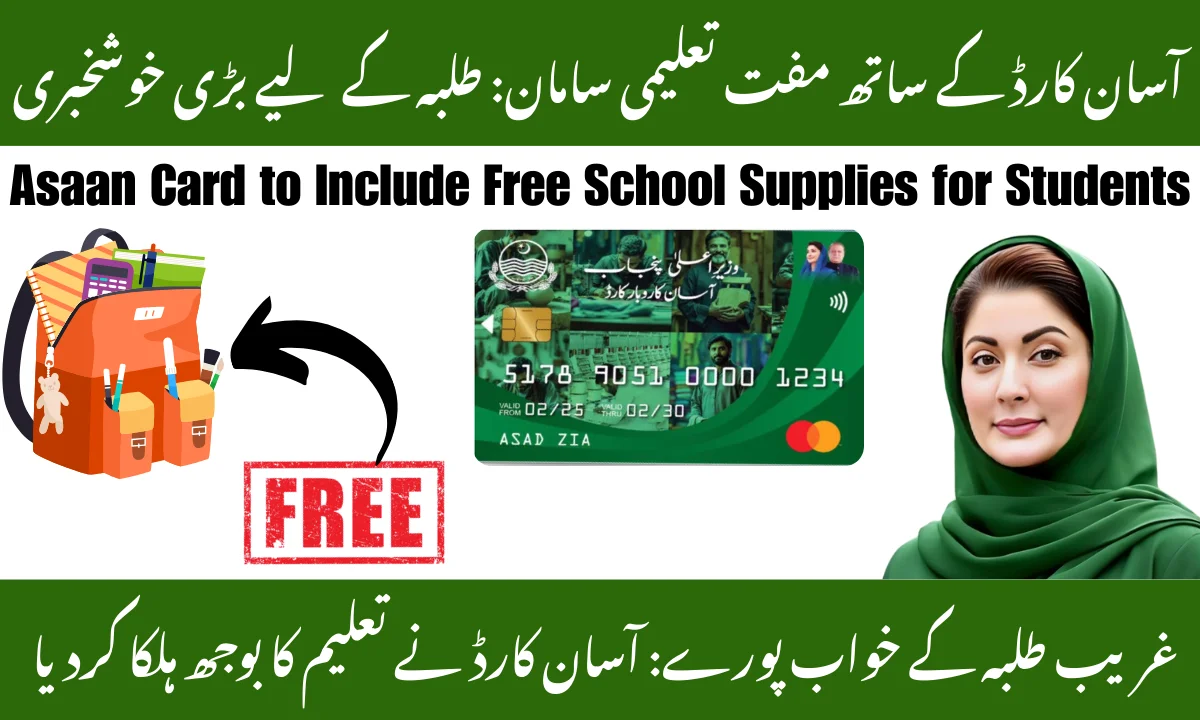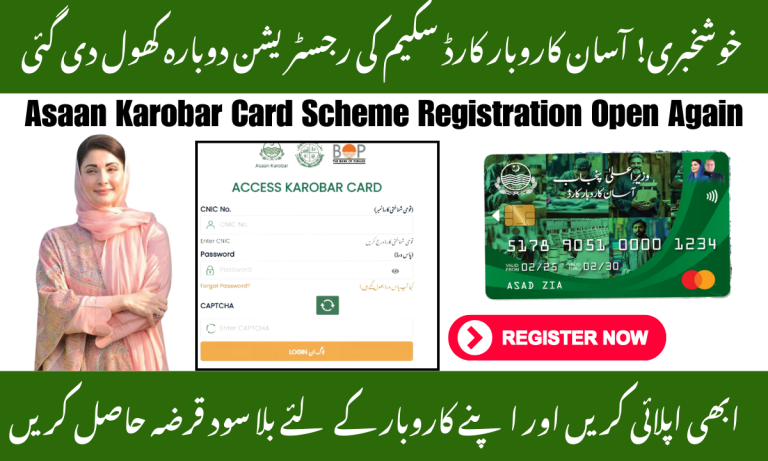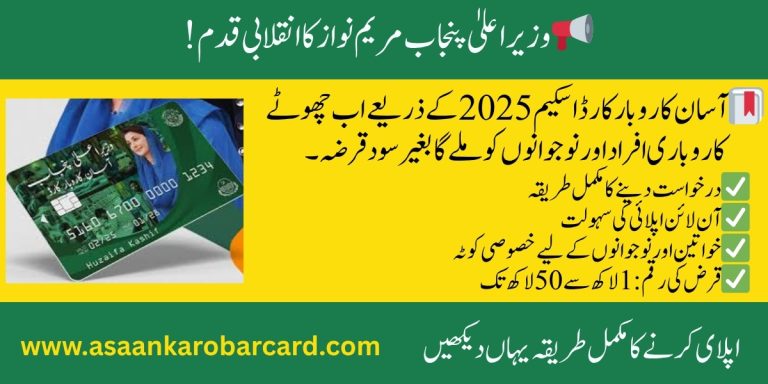Asaan Card to Include Free School Supplies for Students 2025
Education is the right of every child, yet many families in Pakistan face difficulties in affording even the most basic learning materials. The rising cost of books, stationery, and uniforms often leads to stress for parents and becomes a hurdle for children’s education.
The government’s new decision of Asaan Card to Include Free School Supplies for Students is a historic step. It directly supports families who struggle with school-related expenses, especially those in rural and underprivileged communities.
This asaan karobar program is not just about distributing books or bags, it’s about empowering children, motivating them to attend school, and encouraging parents to keep their kids enrolled. By making education less costly, the government is also tackling dropout rates.
Most importantly, this initiative shows a long-term commitment to improving literacy, supporting poor families, and reducing inequality in access to quality education.

Key Highlights of the Article In One Sight
| Feature | Details |
| Scheme Name | Asaan Card Scheme |
| New Addition | Free school supplies for students |
| Supplies Included | Textbooks, stationery, uniforms, school bags |
| Beneficiaries | Students from primary to secondary level |
| Registration | Online and offline methods available |
| Documents Required | CNIC, B-Form, proof of enrollment |
| Nationwide Coverage | Urban and rural areas across provinces |
| Expected Impact | Reduced school expenses, higher enrollment, poverty alleviation |
Introduction to the Asaan Card Scheme
The Asaan Card Scheme was first introduced as a welfare initiative to provide financial assistance and relief to low-income families. Over time, the card has been linked with several subsidy programs like groceries, healthcare discounts, and support for daily living.
Its purpose has always been clear: to bring relief to citizens, reduce the cost of living, and ensure social protection. With the addition of free school supplies for students, the Asaan Card has entered a new phase of welfare,this time focusing directly on the education sector.
This integration not only benefits parents but also aligns with broader government efforts for poverty alleviation and human development.
Why the Government Added School Supplies to the Scheme
The government recognized that one of the hidden barriers to education is the cost of basic supplies. Families may enroll their children in school, but many struggle to afford textbooks, stationery, and uniforms.
Adding free school supplies to the Asaan Card scheme is a practical solution. It reduces the financial load on parents, especially at the start of the academic year when expenses peak. This step is also meant to encourage consistent attendance and improve enrollment rates in both rural and urban areas.
Furthermore, by offering these supplies under an existing card system, the process becomes transparent, digital, and accessible. It shows a vision for equal opportunities and poverty reduction through education.
This decision also reflects the government’s focus on long-term educational reforms. Instead of offering one-time relief, the inclusion of school supplies ensures sustainable support for families. It creates a direct link between welfare and education, proving that social protection can be designed to uplift future generations
New Addition: Free School Supplies for Students
Under this new program, Asaan Card to Include Free School Supplies for Students, families will receive a package of essential items. These include:
- Textbooks for each class level
- Notebooks and stationery items
- School bags
- Uniform support for selected grades
- Geometry boxes and drawing kits for higher classes
This initiative is designed to cover both primary and secondary school students, ensuring that no child is left behind due to financial constraints.
Importance of Free School Supplies in Education
Free school supplies play a much bigger role than just saving money. They have a direct impact on children’s confidence, motivation, and attendance.
For parents, it reduces the constant pressure of arranging funds for books and uniforms. For students, it brings joy and pride in going to school with proper supplies. And for society, it means better enrollment, lower dropout rates, and a stronger literate community.
By removing these barriers, the government is ensuring that children can focus on learning rather than worrying about resources.
Another important aspect is psychological impact. When children receive proper supplies, they feel included and valued. This sense of dignity builds self-confidence, which directly improves academic performance. A child with the right tools is more likely to enjoy school and take learning seriously.
Government’s Educational Support Initiatives
This is not the first time Pakistan’s government has stepped up for education. Over the years, various programs like free textbooks distribution, scholarship schemes, and education subsidies have been launched.
However, what makes this step unique is that it is directly linked to the Asaan Card Scheme, which already has a wide reach. This integration ensures that educational support is not scattered but delivered in a coordinated and transparent manner.
Such efforts also contribute to the broader vision of poverty alleviation through education and skill-building.
Moreover, connecting school supplies with the Asaan Card ensures accountability and reduces misuse. Since the card already operates under a structured welfare system, families can trust that benefits will reach them on time. It also allows the government to monitor impact more effectively and expand future educational initiatives.
Distribution Process of Free Supplies through Asaan Card
The distribution of school supplies will be done in a simple and organized way. Families registered under the scheme will be notified, and supplies will either be collected from designated centers or directly provided through schools.
Transparency will be maintained using a digital system, ensuring that every registered student gets their share. Parents will need to provide basic documents to confirm eligibility.
This approach ensures that benefits reach the right families without middlemen or misuse of resources.
Required Documents for Student Registration
To ensure fairness and transparency, parents need to provide some documents. These documents confirm student identity and enrollment:
- CNIC of parent or guardian.
- B-Form or Child Registration Certificate of student
- Proof of school enrollment (admission slip or school letter)
- Contact information for verification
- Utility bill (for address verification, if needed)
Methods for Registration (Offline and Online)
The government has made registration simple by offering two methods:
Offline Registration
Parents can visit designated Asaan Card centers or schools to register. They must submit the required documents and fill a short form. This method is especially useful for rural families who may not have internet access.
Online Registration
For families with internet access, an online portal will be available. Parents can upload scanned copies of the documents and fill out the registration form digitally. Once verified, they will receive confirmation through SMS or email.
Expected Number of Students to Benefit Nationwide
The program is expected to benefit millions of students across Pakistan. According to early estimates, the initiative will cover children in both urban and rural areas, with special focus on underprivileged families.
Below is a quick table summarizing the expected coverage:
| Area | Expected Beneficiaries |
| Urban Areas | 2–3 million students |
| Rural Areas | 3–4 million students |
| Remote/Tribal Regions | 500,000+ students |
| Total Nationwide | 6–7 million students |
This scale of distribution makes it one of the largest student welfare programs in the country’s history.
Benefits for Families and Students
The benefits of this program go far beyond financial relief. Here are 15 major benefits explained:
- Reduced financial burden on parents
- Free textbooks for all grades
- Free notebooks and stationery kits
- School bags for students
- Support for school uniforms
- Improved school enrollment rates
- Reduced dropout rates
- Motivation for students to attend regularly
- Equal opportunities for children from poor families
- Relief for rural and remote households
- Strengthened link between families and schools
- Support for teachers in ensuring attendance
- Better concentration on studies without stress of expenses
- Encouragement for girls’ education in rural areas
- Long-term contribution to literacy and skilled workforce
Each of these benefits shows that this initiative is not just about supplies, but about shaping the nation’s educational future.
Challenges and Implementation Issues
No program is without challenges, and the same applies here. Distribution in remote areas, maintaining transparency, and raising awareness among parents are some hurdles. However, with proper planning, use of digital tracking, and collaboration with schools, these issues can be resolved effectively.
Another major issue is ensuring that supplies reach the right students at the right time. In the past, some welfare programs faced delays due to logistical inefficiencies. To avoid this, authorities will need to establish strict monitoring systems and use modern technology to track distribution. This will prevent duplication, misuse, or late deliveries.
In addition, awareness is a challenge in rural and underdeveloped areas. Many parents may not know how to register or may lack the required documents. For such communities, special awareness drives, help desks at schools, and mobile registration units can play a vital role in making sure no child is left out of the program.
Role of Teachers and Schools in Program Success
Teachers and schools are central to making this initiative a success. Schools will not only distribute supplies but also encourage parents to register. Teachers can monitor attendance and ensure that children who receive supplies actually benefit from them. By acting as a bridge between government and families, schools will ensure smooth implementation.
Beyond distribution, teachers can also provide valuable feedback to the government. They are in direct contact with students and parents, so they can highlight gaps, challenges, or areas of improvement in the program. This feedback loop will help refine the initiative and make it more effective in the future.
Furthermore, schools can use this opportunity to promote the importance of education and highlight how free supplies reduce financial stress. When parents see that the government is actively investing in their children’s future, they are more likely to keep their kids enrolled and motivated. This creates a positive cycle of trust between schools, parents, and authorities.
Public Opinion on Adding School Supplies to Asaan Card
The public reaction has been highly positive. Parents appreciate the relief, and many believe this will reduce dropout rates. Students are excited about receiving free books and bags. Communities see it as a sign of hope and commitment from the government towards building a literate nation. Some concerns about distribution speed exist, but overall feedback is encouraging.
Interestingly, many parents have expressed that this initiative has restored their confidence in the education system. For low-income families, even small costs of notebooks or uniforms can be overwhelming. By covering these costs, the government has shown it understands the struggles of common people. This sense of inclusion and care strengthens public trust in welfare programs.
Students themselves are also responding positively. Receiving new books, bags, and stationery boosts their motivation and self-esteem. Many children feel proud to go to school with proper supplies, and this emotional connection to learning can significantly reduce absenteeism. Over time, this will improve literacy rates and make communities more supportive of formal education.
Conclusion
The decision of Asaan Card to Include Free School Supplies for Students is more than just a welfare measure,it is an investment in the country’s future. By supporting families, reducing educational expenses, and motivating children, the government is taking a strong step towards equality and literacy. If implemented effectively, this initiative will not only provide immediate relief but also strengthen Pakistan’s education system in the long run.
In the bigger picture, this initiative aligns with global goals of sustainable development and education for all. By making education affordable and accessible, Pakistan is investing in human capital,the most valuable resource for national growth. A literate, skilled, and motivated generation will contribute to economic progress, reduce poverty, and uplift society as a whole.
Ultimately, this initiative proves that small steps can bring large-scale changes. Free supplies may seem like a basic provision, but for millions of children, it is the difference between dropping out or staying in school. The Asaan Card has now become not just a financial aid tool but also a bridge to a brighter educational future.

FAQs
Q1: Who is eligible for free school supplies under the Asaan Card?
All students from low-income families have already registered under the Asaan Card scheme.
Q2: What documents are required for registration?
Parent’s CNIC, student’s B-Form, and proof of school enrollment.
Q3: Are these supplies available in every province?
Yes, the program is planned for nationwide coverage.
Q4: Can parents register online?
Yes, online registration is available along with offline methods.
Q5: How will this initiative affect school enrollment?
It is expected to significantly increase enrollment and reduce dropout rates.






